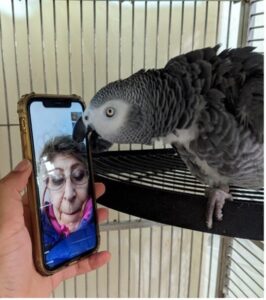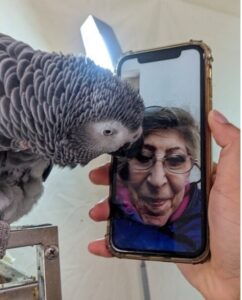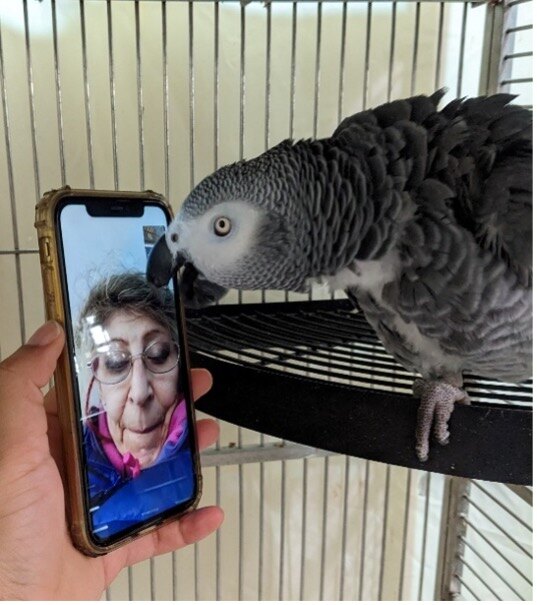
Prior to COVID, my parrots were used to my erratic travel schedule—yes, on my return from a trip I’d get the “cold wing” for a bit, but it was a common occurrence for me to tell them on a given evening something like, “You be good, I’ll see you in 6 days” instead of “tomorrow” or “Monday.”
And although Griffin does know numbers, Athena does not—but they both understand the difference between the two common endings (“tomorrow”, “Monday”) and the odd one (“x days/weeks). They both would exhibit a bit of surprise (pupil size, feathers/head position) at the latter. Nevertheless, they’d still gently nibble my nose with their beaks in farewell, and they seemed to accept that my random appearances and disappearances were just part of life.
Then came COVID…and for over two years, they saw me regularly. My schedule would change a bit from semester to semester, depending on how we were splitting up lab shifts among the few of us still working, but for months at a time, Griffin and Athena could depend on my presence at a given day and a given time. No more traveling, no more erratic schedule.
Zooming With the Flock

And, of course, COVID brought videoconferencing: ZOOM and Skype. I’d meet with my lab manager regularly that way, and with former students with whom I kept in touch. Griffin and Athena seemed to understand something about the system. Although both would tap even a blank phone screen—maybe they saw an interesting reflection? When a familiar person was on a laptop or phone screen, they would aim for the nose to give it their beak taps, suggesting that they had some recognition of who was on the screen. Did they recognize the face or the voice? We don’t know; they could have just recognized the voice and aimed for the appropriate bit of face. And we didn’t do formal tests to see how they might respond to strangers.
We tried to take advantage of their screen-related behavior with respect to training sessions. Recall that during the worst of COVID, only one person was in the lab at a time—which meant we couldn’t do our normal two-person modeling (our M/R training). We, therefore, tried working over ZOOM, but it didn’t go well at all! Neither bird would respond to questions nor even stay attuned. Possibly they associated video with play-time rather than work? Maybe something about the video wasn’t clear enough (either the sound or picture—or both)?
Remember, their hearing range is different from ours (Gupfinger & Kaltenbrunner, 2017), so even if they could distinguish a voice from some other electrical noise, that doesn’t mean they could distinguish specific speech sounds. Ditto for their vision—they see in the ultraviolet (Birkhardt, 1989), so what they actually view on a screen is likely some oddly reduced version of reality.
Whatever Griffin and Athena did or did not see or hear, did or did not know, their behavior still suggested some way to deal with my post-COVID travel schedule and the extent to which it seemed to upset them. “Cold wing” was actually becoming a far too common reaction to me! What if I could interact with them, at least a bit, during the longer trips?
So, when I went to Australia for two weeks in November, I arranged a time to do “WhatsApp”…not easy, given that there is a 15-hour time difference between Sydney and Boston. For example, if it’s 4 p.m. in Boston, it’s 7 a.m. the next day in Sydney! When we tried it, both birds seemed really excited and it seemed to help at least a bit with their reactions upon my return.
So, as I sit in an airport lounge in LAX, en route to 10 days in Hong Kong, I’m eager to see what happens this time. A student and I tested her phone just before I left (pix below of a very, very tired Irene and two seemingly interested parrots!). Fingers crossed that I’ll be able to connect with them and that they will enjoy the process.
References

1 Comment